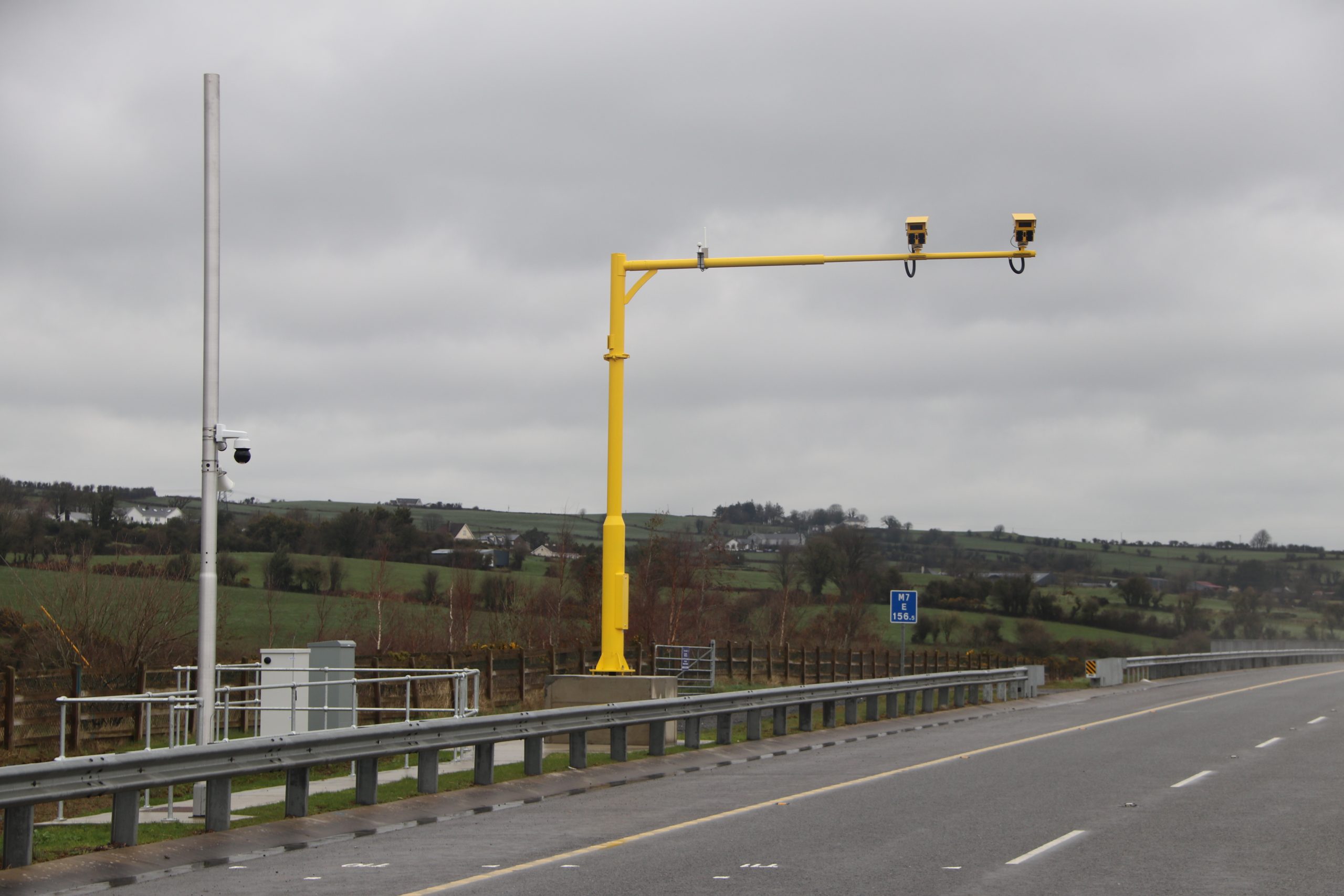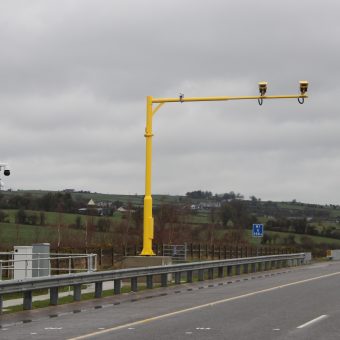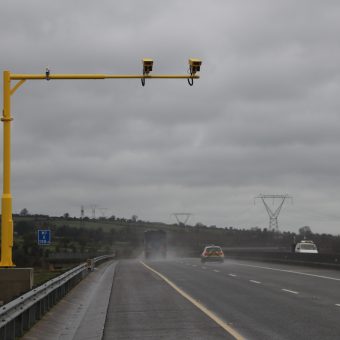Pilot to Commence Installation and Testing from March 8th on M7 in Tipperary (Junction 26-Nenagh (West) and Junction 27-Birdhill).
Transport Infrastructure Ireland (TII), the Roads Safety Authority and An Garda Síochána and are delighted to announce the installation of motorway average speed safety cameras.
Analysis of traffic data by TII shows that speeding is typical of driver behaviour on low traffic volume sections of the motorway network throughout the country. This type of driver behaviour is very dangerous, and it is compounded during rain or hail showers increasing the potential of serious accidents.
TII has analysed speed data on the M7 corridor since 2017 and identified speeding as a significant issue with approx. 40 % of drivers exceeding the 120 km/h speed limit on certain sections. Further, the data identified that speeds are not being appropriately moderated in response to adverse weather conditions such as heavy rain or low road temperatures.
The pilot average speed safety camera system will be deployed between Junction 26-Nenagh (West) and Junction 27-Birdhill, covering both directions and will be Ireland’s first mainline motorway based system. An identical system has been operational within the Dublin Tunnel since mid – 2017 and it has been hugely successful in improving driver behaviour as regards speeding with the number of drivers exceeding the speed limit of 80 km/h dropping from about 55% to just over 10%.
The specific locations chosen have been subject to frequent weather-related/micro-climate events (mostly hail) resulting in increased collision frequency in the area. The locations also have suitable sites to host the required equipment, enable appropriate signage, conspicuously and visibility requirements to be met, and have associated infrastructure that has allowed proper baselines to be established for the study.
The installation of equipment at the M7 sites commenced on the 8th of March 2021 and will be followed by a period of testing and commissioning. At the M7 locations, motorists will soon see the roadside equipment being deployed for the camera system. This will include the yellow poles and cameras traditionally associated with speed measurement equipment.
The ‘go-live’ date for operations will be determined by An Garda Síochána and there will be a formal press briefing / announcement at least 10 days prior to that time. This is to help raise awareness of the safety cameras and encourage all road users to slowdown and help save lives. A system of fixed cautionary signage will be in place to indicate the average speed zone with additional Variable Message Signs (VMS) being used to highlight the go-live date. Prior to the commencement of any operations, the average speed zone will be clearly identified by appropriate signage and Variable Message Signs (VMS) will be used to inform motorists of the go-live date along with additional press briefings.
The objective is to secure compliance, not prosecutions.
An Garda Síochána Superintendent Tom Murphy; “This system will save lives and make our roads safer. An Garda Síochána are delighted to work with TII and RSA to implement this project. We wish to make all drivers aware of
- The dangers when using this section of the roads network
- The particular danger of hail showers adverse weather conditions in this areas.
- Average speed cameras which will be soon be in use.
- The need for drivers to reduce their speed and play their part in saving lives.
- Our promise to prosecute speeding drivers to help save lives.
The success of this initiative will see a change in driver behaviour as the current speeds on the M7 are totally unacceptable. 24/7 monitoring of speed will soon be in place. The success of the project from the viewpoint of An Garda Síochána will be greater compliance and the message is simple #Speed kills so #Slowdown.
In 2020, there were a total of 357 speeding detections made in the vicinity of Junction 26 and Junction 27 by Go Safe and An Garda Siochana.
Kevin O’Rourke TII Head of Network Operation said;
The success of the Average Speed Safety Camera system in Dublin Tunnel is demonstrated by the reduction in speeding incidents by about 80%. This highlights the potential significant safety benefits for both the road user and our teams working on the motorways from using such systems on the wider motorway network and is in line with international experience.
Michael Rowland, Director, Road Safety, Driver Education & Research, Road Safety Authority said:
It is a proven fact that driving too fast increases your risk of being involved in a serious or fatal collision. Every year, approximately one third of all road deaths in Ireland are linked to speeding. If we all reduced the average speed on our road network by just 5%, we could reduce road deaths by 20% and injuries by 10%. Safety cameras have been in operation in Ireland since November 2010 and are proven life savers. They are about saving lives and preventing injuries. Where safety cameras have been deployed, deaths and serious injuries as a result of speeding have reduced. Everyone has a choice; we can slow down and save a life, or we can speed, risk your own life and the lives of others, in addition to risking penalty points and a fine.
Key Data for the M7 Corridor J21 to J28 (2017 Figures)
- 41% of cars were exceeding the 120 km/h speed limit.
- 31% of cars were travelling at up to and including 135 km/h
- 10% of cars were travelling above 135 km/h
- Only a 2% reduction in cars travelling at above 135 km/h in response to adverse weather
Actions undertaken along the M7 (J21 to J28) in response to incident data:
- Data analysis (traffic, weather etc.) to identify collision circumstances and driver behaviour trends;
- “Wet skid” collision clusters have been identified by An Garda Síochána and TII and have been mitigated with engineering interventions;
- Collaboration amongst all road safety stakeholders to inform motorists of the hazards associated with adverse weather;
- Road Safety Authority adverts regarding hail;
- Met Éireann forecasts including a focus on hail as required;
- TII introduced VMS on M7 at locations most susceptible to hail to warn drivers.
Help support Cork Safety Alerts by becoming a member – Click Here



